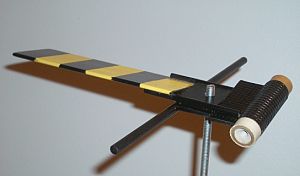
Brief:
The Hornet is the second 18mm monocopter released by Art Applewhite. Similar to his 18mm Dragonfly but with a shorter wing, the Hornet claims to have a more aggressive flight profile.
Construction:
Parts list:
- Wing--2"x6"x1/8" basswood plank
- Balance Beam--8"x1/4" dowel
- Support Dowel--2.75"x3/16" dowels (qty 2)
- Center, Center Support, and Motor Support- 2"x3.25"x1/8" basswood
- Motor Mount Tube--2" BT20 tubing
- Motor Reinforcement--fiberglass tape
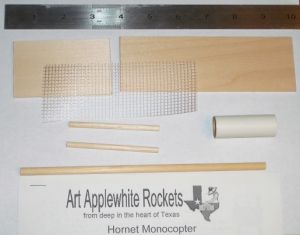 The kit came in a heat-sealed plastic bag. The USPS Express Mail cardboard box that it was shipped in was partially crushed and had dirt and grass stains on it, but the contents were unharmed.
The kit came in a heat-sealed plastic bag. The USPS Express Mail cardboard box that it was shipped in was partially crushed and had dirt and grass stains on it, but the contents were unharmed.
The instructions are remarkably concise for a model of this complexity. The assembly instructions fit on two 8.5"x11" laser-printed pages with a third page describing flight preparation. The illustrations clearly show the key dimensions and alignment at each critical step. Although it is not mentioned in the text, the illustrations on the first page are full size. This allows them to be used as templates for cutting and aligning the pieces.
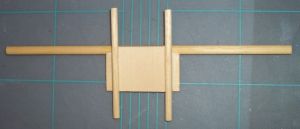
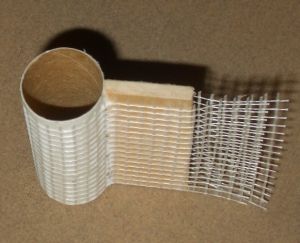
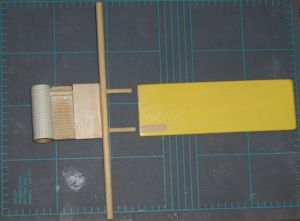
The build process takes 11 steps including finishing. Elmer's Glue All is used throughout. I asked Art about using Carpenters Glue instead. He recommended against it because carpenter's glue shrinks a lot and gets brittle, an undesirable trait during hard landings.
First the center plate, center support, and motor support are cut from the short piece of basswood plank. The center pieces are glued to each other with their grains perpendicular for strength. Then the support dowels are glued to the center supports, followed by the balance beam dowel.
The support dowels serve multiple purposes on a monocopter. In addition to holding the motor mount and the wing to the center section, their thickness and spacing help set the angles for the motor and the wing.
The wing is glued to the center section at an angle, with one edge under a support dowel and the other edge over the other dowel. I cheated a little.
The motor mount tube is glued to the motor support. After the glue has dried, the tube and support are both wrapped with fiberglass tape and the tape is coated with glue. When I built mine, the glue joint between the tube and the support must not have been completely dry. When I coated the glass tape with glue, the support came loose from the tube and slid around. That is why I recommend jumping out of sequence and gluing the support to the motor tube much earlier in the process so that it has a chance to dry before applying the fiberglass tape.
After the glue has dried on the fiberglass, the motor assembly is attached to the center section. One edge goes under a support dowel and the other edge goes over. When done properly, the wing will tilt one direction and the motor will tilt in the opposite direction. The illustrations clearly show the correct orientation of all the parts.
Finally, a ¼" launch guide hole is drilled in the center section (but not in the center of the center--it is offset a little bit). This is another step that would be easier if it were done earlier, before the angled wing and motor assembly were attached.
Finishing:
There is no mention of sanding any of the parts in the instructions. I wasn't sure if rounding or airfoiling the edges would affect the flight characteristics, but Art assured me that doing so would make little difference. I sanded the flat wing surfaces smooth and rounded the sharp edges.
The kit comes with no decals and color choices are left to the creativity of the builder. The instructions say to apply two coats of clear enamel to protect the wood and glue from moisture and dirt. I wanted something more colorful so I asked Art if paint or MonoKote would work without screwing up the balance. He said they would be fine as long is I didn't get carried away.
In keeping with the Hornet name, I decided to paint mine yellow and black. I skipped my usual multiple steps of priming and sanding and went directly to the final colors to save weight and time. After masking off all the surfaces that would need to be glued, I painted the wing with Rustoleum Sunset Yellow. The rest of the body was painted with Rustoleum Gloss Black. After drying overnight I used low-tack masking tape and Gloss Black paint to put black stripes on the wing.
Construction Rating: 4 out of 5
Flight:
The Hornet was designed to fly on any 18mm black-powder motor with a short or medium delay (A8-3, B4-2, B4-4, B6-0, B6-2, B6-4, C6-0, C6-3). Long delays should be avoided because the ejection charge will not fire until the rocket has reached the ground, thus creating a fire hazard.
Flight preparation is very simple:
- Wrap a 3/8" wide strip of masking tape around nozzle end of motor.
- Insert motor into motor tube.
- Insert igniter.
- Connect igniter leads, making sure that they won't get snagged when the copter is spinning on the pad.
Speaking of pads, the recommended launch rod is a half-inch long #¼-20 bolt. Longer or thinner rods are not recommended. Art includes plans for making a simple pad using 2"x4" lumber, a bolt and nut, and a few wood screws. My launch pad already has a #¼-20 threaded rod that holds a drill chuck. I merely unscrewed the chuck and put a nut on the threaded rod to keep the rocket from sliding down too far. No blast deflector is needed.
For the maiden flight, I used a B4-2. At ignition, the copter quickly spun up with a rising buzzing sound and flew straight up leaving a tight corkscrew smoke pattern. Despite the 15-20mph wind, the copter did not weathercock at all but merely slid sideways downwind as it was flying. After burnout, it fluttered down to a soft landing. Despite landing on very hard ground, the Hornet suffered no damage.
The second flight flew on a C6-3. This is a great motor for this kit. The spin-up and takeoff were again vertical with a slide-side downwind. The higher thrust and longer duration of the C6 vs the B4 led to a higher-pitched buzz and a higher altitude at burn-out. Again it fluttered to a soft land on hard ground.
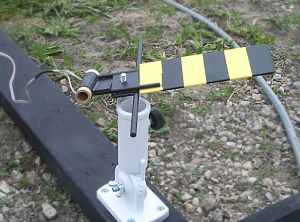
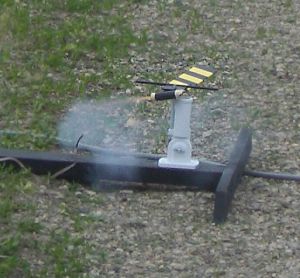
Recovery:
Inspection after the second flight revealed a hole burned through the motor casing and the motor mount tube on the edge opposite the blade. Apparently this is a common issue with monocopters because the centrifugal force causes the hot fuel particles to collect on the outside edge above the nozzle. The damage to the tube is not so bad that it won't be able to fly again, but I wonder how many flights it can tolerate. If the burn-through always happens in the same location then the damage to the motor mount tube may not get any worse.
Flight Rating: 4 out of 5
Summary:
PROs:
- Unusual design--definitely not three fins and a nose cone.
- Interesting flight profile--not another "whoosh-pop" up-and-down flight.
- Clear directions.
- Flies well even in windy weather, and short walks for recovery.
CONs:
-
- Motor burn through side of casing and motor mount tube.
Starting with the Dragonfly and continuing with the Hornet, Bumblebee, and Whirlwind, Art Applewhite has taken the mystery out of monocopters and made them accessible to the masses. For years Art has had a reputation as the "saucer king." If the rest of his monocopter kits are as good as the Hornet, he may soon be able to claim the title of "monocopter monarch" as well.
Overall Rating: 4 out of 5


 The kit came in a heat-sealed plastic bag. The USPS Express Mail cardboard box that it was shipped in was partially crushed and had dirt and grass stains on it, but the contents were unharmed.
The kit came in a heat-sealed plastic bag. The USPS Express Mail cardboard box that it was shipped in was partially crushed and had dirt and grass stains on it, but the contents were unharmed.























B.C. (July 20, 2008)